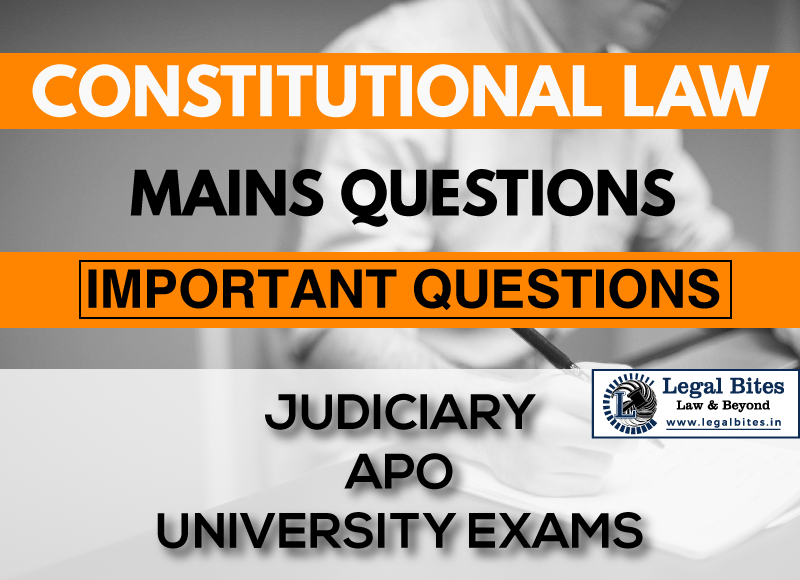Write a short note on Salient features of Indian Independence Act, 1947
Question: Write a short note on the Salient Features of the Indian Independence Act, 1947. [BJS 1987] Find the answer to the mains question only on Legal Bites. [Write a short note on the Salient Features of the Indian Independence Act, 1947.] Answer The Indian Independence Act, 1947 was the last legislation of the British Parliament passed with the… Read More »

Question: Write a short note on the Salient Features of the Indian Independence Act, 1947. [BJS 1987] Find the answer to the mains question only on Legal Bites. [Write a short note on the Salient Features of the Indian Independence Act, 1947.] Answer The Indian Independence Act, 1947 was the last legislation of the British Parliament passed with the intent of creating an independent India. As per the recommendation of the Cabinet Mission Plan, the Constituent Assembly was established...
Question: Write a short note on the Salient Features of the Indian Independence Act, 1947. [BJS 1987]
Find the answer to the mains question only on Legal Bites. [Write a short note on the Salient Features of the Indian Independence Act, 1947.]
Answer
The Indian Independence Act, 1947 was the last legislation of the British Parliament passed with the intent of creating an independent India. As per the recommendation of the Cabinet Mission Plan, the Constituent Assembly was established presided by Dr. Rajendra Prasad for making the Constitution. However, the proposal of Cabinet Mission though accepted by Congress was rejected by the Muslim League. Resultantly, communal riots occurred throughout the country and finally, Clement Attlee, the then Prime Minister of England declared the transfer of power on 20th February 1947.
The British Government sent Lord Mountbatten to transfer power to India who held consultations with all political leaders and found that a compromise between Congress and the Muslim League was impossible on the basis of United India and agreement reached on the basis of partition. Thus, the Act Indian Independence Act of 1947, an extension of the Mountbatten plan was passed with some essential provisions. They are as follow:
- The Indian Independence Act of 1947 provided that on 15th August 1947, the appointed date, two independent dominions, India and Pakistan, would be set up and the Act provided for the complete transfer of power.
- The dominion of India for the territory of Bombay, Madras, U.P., Central Province, Bihar, East Punjab, West Bengal, Assam, Delhi, Ajmer, Coorg, etc., and the rest of India except Sindh, Baluchistan, West Punjab, East Bengal, North-West Frontier Province and Sylhet in Assam which became the territories of Pakistan. For demarcating the boundaries, Boundary Commission was formed with Sir Cyril Radcliffe as the Chairman.
- The Crown was no longer the source of authority.
- The Governor-General and Provincial Governors were to act as Constitutional heads. They lost extraordinary powers to legislate.
- The office of the Secretary of State was abolished.
- From the 15th of August, 1947, the British Crown lost all rights of Paramount over India and the Indian states were free to join either Indian Union or Pakistan.
- The power in each dominion was transferred to the Constituent Assembly which became fully sovereign from 15th August 1947 and was absolutely free to frame the Constitution. The Constituent Assembly had a dual role i.e. Constituent and Legislative. They functioned as Central Legislature till the new legislatures were formed.
- Until the new Constitution was framed, the Act of 1935 would govern the Centre and the Provinces with necessary modifications.
The result of the enactment of the Indian Independence Act, 1947 was that India and Pakistan after partition emerged as free nations. And the Independence of India is remembered as one of the greatest events of history that were achieved after long and glorious years of struggle.
Important Mains Questions Series for Judiciary, APO & University Exams
- Constitutional Law Mains Questions Series Part-I
- Constitutional Law Mains Questions Series Part-I
- Constitutional Law Mains Questions Series Part-II
- Constitutional Law Mains Questions Series Part-IV
- Constitutional Law Mains Questions Series Part-V
- Constitutional Law Mains Questions Series Part-VI
- Constitutional Law Mains Questions Series Part-VII
- Constitutional Law Mains Questions Series Part-VIII
- Constitutional Law Mains Questions Series Part-IX
- Constitutional Law Mains Questions Series Part-X
Admin Legal Bites
Legal Bites Study Materials correspond to what is taught in law schools and what is tested in competitive exams. It pledges to offer a competitive advantage, prepare for tests, and save a lot of money.

